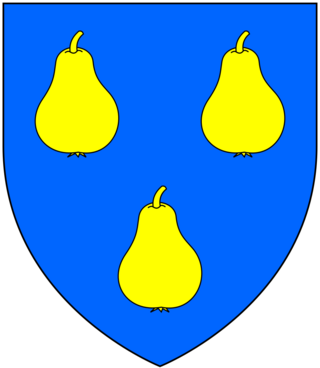Related Research Articles
Sir John Guildford, JP, of Hemsted in Benenden, also written Guilford, was an English landowner, administrator and politician.

Rolvenden is a village and civil parish in the Ashford District of Kent, England. The village is centred on the A28 Ashford to Hastings road, 5 miles (8.0 km) south-west of Tenterden.

Nicholas Carew, of Beddington in Surrey, was an English lawyer, landowner, courtier, administrator and politician who served as Keeper of the Privy Seal during the reign of King Edward III.
Kent was a parliamentary constituency covering the county of Kent in southeast England. It returned two "knights of the shire" to the House of Commons by the bloc vote system from the year 1290. Members were returned to the Parliament of England until the Union with Scotland created the Parliament of Great Britain in 1708, and to the Parliament of the United Kingdom after the union with Ireland in 1801 until the county was divided by the Reform Act 1832.
Sir Thomas Browne was a Member of Parliament and Chancellor of the Exchequer. Browne's tenure as Chancellor occurred during the Great Bullion Famine and the Great Slump in England. He was executed for treason on 20 July 1460.
Sir William Hawte was a prominent member of a Kentish gentry family of long standing in royal service, which, through its near connections to the Woodville family, became closely and dangerously embroiled in the last phases of the Wars of the Roses.

Sir Richard Guildford KG was an English courtier, administrator, politician and military leader who held important positions under King Henry VII.

Sir John Fogge was an English courtier, soldier and supporter of the Woodville family under Edward IV who became an opponent of Richard III.
Iden Green is a small village, near Benenden, in the county of Kent. It belongs to the civil parish of Benenden and the Tunbridge Wells Borough District of Kent, in the South East of England.

John Hales, of The Dungeon in the parish of St. Mary Bredin, Canterbury, Kent, was an administrator, politician and judge who was appointed a Baron of the Exchequer in 1522.
Sir Christopher More was an English administrator, landowner, and Member of Parliament. More was the son of John More, a London fishmonger, and his wife, Elizabeth. He was active in local administration in Sussex and Surrey, and from 1505 until his death held office in the Exchequer, rising in 1542 to the post of King's Remembrancer. His sister, Alice More, was the fourth wife of Sir John More, father of Sir Thomas More.

Richard Stucley, of Merston and Chewton Mendip, was an English landowner, administrator and politician who married an heiress and through his son Hugh, who also married an heiress, became the ancestor of a major Devon family.
Nicholas Gainsford, also written Gaynesford or Gaynesforde, of Carshalton, Surrey, of an armigerous gentry family established at Crowhurst, was a Justice of the Peace, several times Member of Parliament and High Sheriff of Surrey and Sussex, Constable and Keeper of Odiham Castle and Park, Hampshire, who served in the royal households from around 1461 until his death in 1498. Rising to high office during the reign of Henry VI, he was an Usher to the Chamber of Edward IV and, by 1476, to his queen Elizabeth Woodville. Closely within the sphere of Woodville patronage, he was a favourer of Edward V, and was a leader in the Kentish rising of 1483 against Richard III. He was attainted in 1483, but was soon afterwards pardoned, and fully regained his position and estate as Esquire to Henry VII and Elizabeth of York after the Battle of Bosworth Field. He established the Carshalton branch of the Gainsford family.
Sir John Guildford, was an English landowner, administrator and politician from Kent.

Halden is an historic manor in the parish of Rolvenden in Kent, England. The manor house was later known as Halden Place and is a Grade II listed building. It was the seat of the de Halden family until the death of John Halden without male progeny when his daughter and heiress brought it to the Guldeford, a member of whom she had married. Her grandson Sir John Guildford (1420–1493) of Halden was Comptroller of the Household to King Edward IV. On 6 October 1487 he obtained royal licence to crenellate his house at Halden, together with other of his residences. The arms of Guldeford quartering de Halden survive on the Christchurch Gate of Canterbury Cathedral, built in 1517. Lady Jane Grey (c. 1537-1554), "the Nine Days' Queen", lived at Halden Place. Today the remains of Halden Place comprise a large farmhouse situated about a mile and a quarter north of Rolvenden Church. The arms of Guldeford survive sculpted in stone on the stable-block.

William Darell or Darrell was an English Anglican clergyman and antiquarian.

Scadbury is a historic manor in the parish of Chislehurst in the London Borough of Bromley, England. Much of the estate is preserved today as Scadbury Park, a 300-acre (120 ha) Local Nature Reserve and a Site of Metropolitan Importance for Nature Conservation. The manorial chapel, known as the Scadbury Chapel, survives in the church of St Nicholas at Chislehurst, and served as a burial place for owners of the estate, including members of the Walsingham family.
Nicholas Wotton was an English merchant and official who twice served as Lord Mayor of London, in 1415 and 1430.
William Guildford was an English landowner and politician from Kent who sat as MP for the county in 1380 and 1384 and was Sheriff in 1387.
References
- ↑ Some sources call him Edmund, but that is probably a misreading.
- 1 2 3 4 5 6 7 8 9 10 11 12 J.S. Roskell; L. Clark; C. Rawcliffe, eds. (1993). "GUILDFORD, (d.1448/9), of Halden in Rolvenden, Kent.". The History of Parliament: the House of Commons 1386-1421. Retrieved 12 February 2022.
- 1 2 3 4 5 6 7 8 "Visitation of Kent, 1619" . Retrieved 12 February 2022.